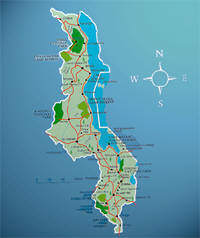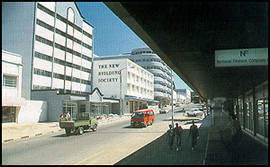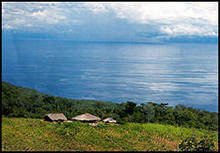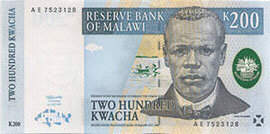 LAND & PEOPLE LAND & PEOPLE |
 COUNTRY DESCRIPTION COUNTRY DESCRIPTION |
 GEOGRAPHY GEOGRAPHY |

Click to enlarge (70Ko)
Malawi is small landlocked country in Africa, south of the Equator covering an area of 118, 484 square km. The country shares borders to the north and northeast with Tanzania, to the east, south and southwest with Mozambique and to the north and northwest with Zambia.
Geographically, Malawi is dominated by Lake Malawi, the southern-most and greatest of the chain of lakes in the Great Rift Valley of Africa and the third largest lake in Africa, which runs southwards parallel to the main strip of land. This Magnificent body of water is 580 km long and 165 km to 80km wide accounting for 20% of Malawi’s total surface area. The country has a varied topography of mountains and rivers, which have a direct effect on the climate. The northern region of Malawi is mountainous, the highest peaks reaching over 3,000m with the rolling Nyika plateau rugged escarpments, valley and the thickly forested slopes of the Viphya Plateau. The central region is mainly a plateau over 1000m high, with fine upland scenery and is the country’s main agricultural area. The southern region is low lying with the 2100m high Zomba Plateau south of Lake Malawi and the huge isolated Mulanje massif in the southeast, the highest mountain in central Africa.
 THE MAIN CITIES THE MAIN CITIES |
LILONGWE
Lilongwe is the official capital city of the country since 1975, and is known as the "garden city". The city is mainly governmental and is divided within two centers: The Capital Hill where the Ministers, Members of the Government, Embassies and travel agents have their offices, and the Old town, a few kilometers away where the market, restaurants and cafes are. Its modern architecture is complemented by colourful flowering trees, open pedestrian precincts and skilful landscaping.
When Malawi became a Republic in 1966, Lilongwe was a small dusty town in the Central Province. His Excellency the Life President, Dr H. Kamuzu Banda, set in motion plans to move the capital city from Zomba to Lilongwe. As a result the fertile region has become the main agricultural area of the country, producing village-grown maize, groundnuts and tobacco.
Kamuzu International Airport, opened in 1983, is the entry point into Malawi, and has all the facilities to handle needs of the modern travellers.
BLANTYRE
Blantyre is Malawi’s main commercial and industrial centre and is set in the hilly country of the Shire Highlands. When Livingstone journeyed through Central Africa in 1859, he set in train a series of missionary visits, and some years later the Church of Scotland established a base here. In 1888, under the direction of Clement Scott, a large mission church building was commenced.

This imposing building was completed three years later with inexperienced labour and today St Michael’s and All Angels stands as a testimony to the pioneering spirit of the early missionaries.
Opportunities for trade developed and a group of Scottish businessmen set up the African lakes Company in Blantyre. The company continues to operate as Mandala Limited, and the old Mandala Manager’s house still stands today.
Coffee, cotton, tobacco and tea plantations were soon thriving in the fertile highlands.
ZOMBA
Only 69 km from Blantyre, Zomba is a major town that has had a large part to play in Malawi’s history. Nestling at the foot of the magnificent Zomba plateau, the town first came into being when it was selected as a potentially viable mission site because of its plentiful water supply from the Mulunguzi streams. Those also offer excellent trout fishing. |
The entire mountain is a forest reserve crisis crossed with clear mountain streams. Pine trees forests, tang and wide umbrellas, trees blend with moses, ferns creeper in a natural mystic experience.
The settlement was established as the colonial administrative capital in 1891 by the first Commissioner of the British Protectorate, Sir Harry Johnston.
Zomba remained the capital until 1975 and is still the seat of Parliament.
Visitors will find many places of interest including the National herbarium, Botanical Gardens, Chancellor college, a fishing fly factory and the KAR war Memorial.
MULANJE
The Mulanje mountain is the highest mountain in Malawi. It is famous for its breathtaking views over the tea plantations that extend for kilometres at its feet and for being home to the most precious tree species of continent the Mulanje cedar. Mountain climbing the Mulanje Massif is a hiker and mountain climber haven.
Mulanje is connected to Malawi’s main commercial city by road, a drive through the countryside or bus ride generally adds to the experience of going to Mulanje.
 ECONOMIC GEOGRAPHY ECONOMIC GEOGRAPHY |
Malawi is an agricultural country and 85% of the population relies on it . Tobacco, Tea, Coffee and Sugar are the main cash crops. Tobacco is largely grown in the highlands and sugar in the low shire valley. Tourism, until now has remained fourth as a foreign exchange earner.
 POPULATION POPULATION |
According to the last population projection that has been realised, the total population for the country and some of the major urban centres is as follows:

Lilongwe 505, 200
Blantyre 506,700
Mzuzu 72, 900
Zomba 71,300
The total population is about 10, 931, 000.
 CLIMATE CLIMATE |
The climate varies from cool in the highlands to warm around Lake Malawi. The country has two seasons: the dry and the wet. The wet season extends form November to April. Rain falls up to between 635mm and 3,050mm. From May to August it is cool and dry, July is the mid winter month. In September, it is hot and dry with October and November as the hottest months. Around Lake Malawi the climate is particularly dry with cooling breezes and record mean daily temperatures ranging from 26°C in January to 21°C in July.
 LANGUAGE LANGUAGE |
The official language is English. Chichewa is widely spoken and is regarded as the national language. French is taught in several secondary schools in the country. There are several other local languages.
All the different ethnic groups have their own language or dialect. The Chewa are the dominant group and their language is Chichewa.
 CURRENCY CURRENCY |

The unit of currency is the Malawi Kwacha (MK) divided into smaller unit denomination called Tambala (1MK= 100 Tambala). Travellers cheques and foreign currency can be exchanged at banks, authorised hotels and other Forex institutions. Many places also accept credit cards. There is no restriction to the amount of foreign currency visitors bring with them but the type and total value must be declared on arrival, especially if all or part is to be exported on departure. Visitors should obtain a stamped customs certificate on arrival or they may find that they are restricted as to the amount they may export.
|

